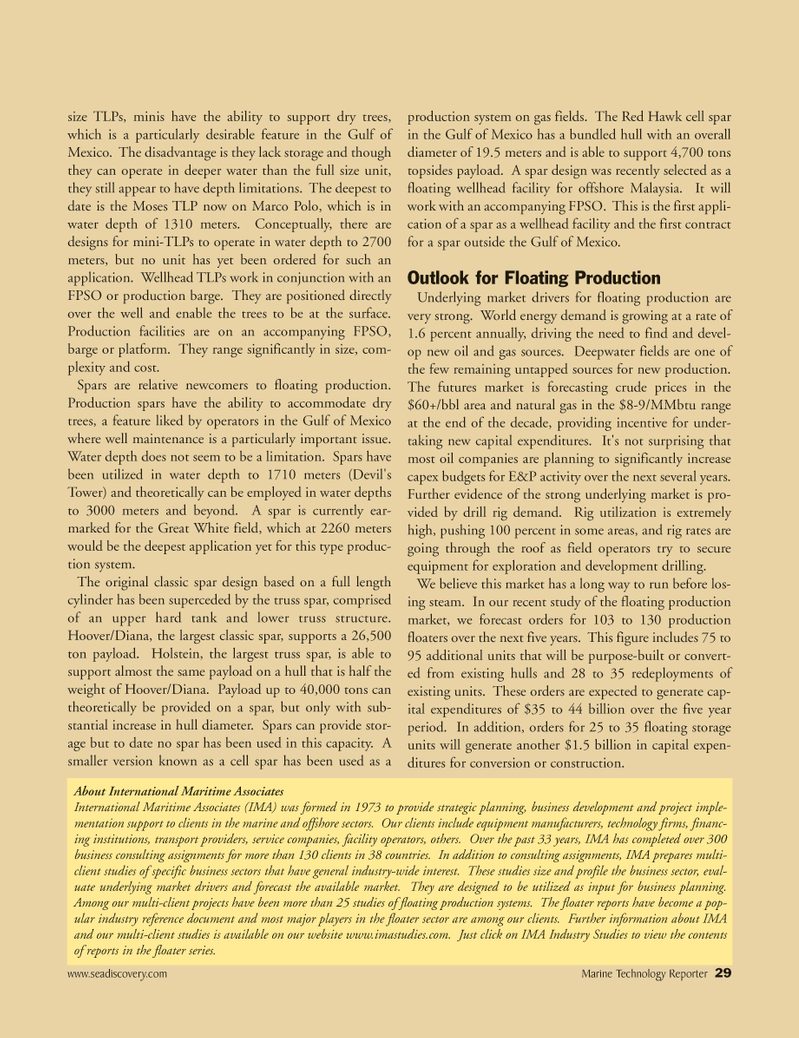
Page 29: of Marine Technology Magazine (April 2006)
The Offshore Technology Edition
Read this page in Pdf, Flash or Html5 edition of April 2006 Marine Technology Magazine
www.seadiscovery.com Marine Technology Reporter 29 size TLPs, minis have the ability to support dry trees, which is a particularly desirable feature in the Gulf of
Mexico. The disadvantage is they lack storage and though they can operate in deeper water than the full size unit, they still appear to have depth limitations. The deepest to date is the Moses TLP now on Marco Polo, which is in water depth of 1310 meters. Conceptually, there are designs for mini-TLPs to operate in water depth to 2700 meters, but no unit has yet been ordered for such an application. Wellhead TLPs work in conjunction with an
FPSO or production barge. They are positioned directly over the well and enable the trees to be at the surface.
Production facilities are on an accompanying FPSO, barge or platform. They range significantly in size, com- plexity and cost.
Spars are relative newcomers to floating production.
Production spars have the ability to accommodate dry trees, a feature liked by operators in the Gulf of Mexico where well maintenance is a particularly important issue.
Water depth does not seem to be a limitation. Spars have been utilized in water depth to 1710 meters (Devil's
Tower) and theoretically can be employed in water depths to 3000 meters and beyond. A spar is currently ear- marked for the Great White field, which at 2260 meters would be the deepest application yet for this type produc- tion system.
The original classic spar design based on a full length cylinder has been superceded by the truss spar, comprised of an upper hard tank and lower truss structure.
Hoover/Diana, the largest classic spar, supports a 26,500 ton payload. Holstein, the largest truss spar, is able to support almost the same payload on a hull that is half the weight of Hoover/Diana. Payload up to 40,000 tons can theoretically be provided on a spar, but only with sub- stantial increase in hull diameter. Spars can provide stor- age but to date no spar has been used in this capacity. A smaller version known as a cell spar has been used as a production system on gas fields. The Red Hawk cell spar in the Gulf of Mexico has a bundled hull with an overall diameter of 19.5 meters and is able to support 4,700 tons topsides payload. A spar design was recently selected as a floating wellhead facility for offshore Malaysia. It will work with an accompanying FPSO. This is the first appli- cation of a spar as a wellhead facility and the first contract for a spar outside the Gulf of Mexico.
Outlook for Floating Production
Underlying market drivers for floating production are very strong. World energy demand is growing at a rate of 1.6 percent annually, driving the need to find and devel- op new oil and gas sources. Deepwater fields are one of the few remaining untapped sources for new production.
The futures market is forecasting crude prices in the $60+/bbl area and natural gas in the $8-9/MMbtu range at the end of the decade, providing incentive for under- taking new capital expenditures. It's not surprising that most oil companies are planning to significantly increase capex budgets for E&P activity over the next several years.
Further evidence of the strong underlying market is pro- vided by drill rig demand. Rig utilization is extremely high, pushing 100 percent in some areas, and rig rates are going through the roof as field operators try to secure equipment for exploration and development drilling.
We believe this market has a long way to run before los- ing steam. In our recent study of the floating production market, we forecast orders for 103 to 130 production floaters over the next five years. This figure includes 75 to 95 additional units that will be purpose-built or convert- ed from existing hulls and 28 to 35 redeployments of existing units. These orders are expected to generate cap- ital expenditures of $35 to 44 billion over the five year period. In addition, orders for 25 to 35 floating storage units will generate another $1.5 billion in capital expen- ditures for conversion or construction.
About International Maritime Associates
International Maritime Associates (IMA) was formed in 1973 to provide strategic planning, business development and project imple- mentation support to clients in the marine and offshore sectors. Our clients include equipment manufacturers, technology firms, financ- ing institutions, transport providers, service companies, facility operators, others. Over the past 33 years, IMA has completed over 300 business consulting assignments for more than 130 clients in 38 countries. In addition to consulting assignments, IMA prepares multi- client studies of specific business sectors that have general industry-wide interest. These studies size and profile the business sector, eval- uate underlying market drivers and forecast the available market. They are designed to be utilized as input for business planning.
Among our multi-client projects have been more than 25 studies of floating production systems. The floater reports have become a pop- ular industry reference document and most major players in the floater sector are among our clients. Further information about IMA and our multi-client studies is available on our website www.imastudies.com. Just click on IMA Industry Studies to view the contents of reports in the floater series.
MTR#3 (17-32).qxd 4/7/2006 11:31 AM Page 29

 28
28

 30
30
